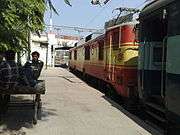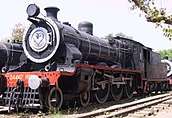Indian locomotive class WAM-4
The Indian locomotive class WAM-4 is a class of 25 kV AC electric locomotives that was developed in the 1970 by Chittaranjan Locomotive Works for Indian Railways. The model name stands for broad gauge (W), AC Current (A), Mixed traffic (M) engine, 4th generation (4). They entered service in March 1971. A total of 500 WAM-4 were built at CLW between 1970 and 1983, which made them the most numerous class of mainline electric locomotive till its successor the WAG-5.
| Indian locomotive class WAM-4 | |||||||||||||||||||||||||||||||||||||||||||||||||||||||||||||||||
|---|---|---|---|---|---|---|---|---|---|---|---|---|---|---|---|---|---|---|---|---|---|---|---|---|---|---|---|---|---|---|---|---|---|---|---|---|---|---|---|---|---|---|---|---|---|---|---|---|---|---|---|---|---|---|---|---|---|---|---|---|---|---|---|---|---|
AJJ WAM-4 hauling an express train | |||||||||||||||||||||||||||||||||||||||||||||||||||||||||||||||||
| |||||||||||||||||||||||||||||||||||||||||||||||||||||||||||||||||
| |||||||||||||||||||||||||||||||||||||||||||||||||||||||||||||||||
| |||||||||||||||||||||||||||||||||||||||||||||||||||||||||||||||||
| |||||||||||||||||||||||||||||||||||||||||||||||||||||||||||||||||
The WAM-4 is one of the most successful locomotives of Indian Railways having served both passenger and freight trains for over 50 years. This class provided the basic design for a number of other locomotives like WCAM-1, WAG-5A, WCG-2, and some WAP models. However, with the advent of new 3-phase locomotives like WAP-5 and WAP-7, the WAM-4 locomotives were relegated to hauling smaller passenger trains and now the aging fleet the WAM-4 locomotives are being rapidly scrapped and have been fully withdrawn from mainline duties.
History
The history of WAM-4 begins in early 1970s with the aim of addressing the shortcomings of the previous WAM-1/2 and WAG 1, WAG-2, WAG-3, WAG-4 classes and remove steam locomotives from IR by a target date of 1990. The WAM-1s were not great successes as some of their advanced features were unsuitable for Indian conditions.
so the designers at RDSO and CLW decided to use the following
- Instead of the Bo-Bo bogies of WAM-1/2, ALCO asymmetric Trimount bogies of the WDM-2 were provided for better traction and power.
- Silicon rectifiers with speed control by three series-parallel motor combinations and weak field operation.
- Auxiliaries from Westinghouse and Kirloskar (compressors), S F India (blowers) and Northey (exhauster)
- Air brakes for loco and vacuum train brakes fitted as original equipment with Rheostatic braking also provided
- MU operation made possible up to 4 units possible.
Production of these locomotives started in 1970 with #20400 and exactly 500 WAM-4s were built in 13 years with #21399 “Anant” being the last one. Production ended on August 3, 1983.WAM-4 though an indigenously produced loco was heavily inspired by French box design and naturally favoured a French TM which was the Alstom made TAO TM. A single WAM-4 can generally haul up to a 24-coach passenger rake.This class proved so successful by virtue of its ruggedness suitable for Indian conditions and simplicity of maintenance. In January 2020, the last WAM-4 units (four from Tata ELS) were withdrawn from manline service.[1][2] Currently 8 locomotive are currently doing shunting and departmental works.
Variants
This loco class has been seen in many variations, as a lot of workshops and sheds have carried out their own enhancements or modifications to the basic loco design. Although the code indicates a mixed-use loco, most WAM-4's ended up hauling passenger trains.
Variants include
- WAM4B or G: Freight only (re geared version)
- WAM4D or DB: Dual Braked (Air and Vacuum)
- WAM4E: Air Brake only (for both loco and train)
- WAM4H: Hitachi Traction Motors instead of Alstom
- WAM4P: Passenger only (re geared version)
- WAM4/2S3P: 2 Traction Motors in Series, 3 in Parallel
- WAM4/6P: 6 traction motors permanently in parallel
- WAM4/6PE: Air braked, 6 Traction Motors perm. in parallel
- WAM4/6PDBHS: 6 Traction Motors permanently in parallel, Dual Brakes, High Speed
- WAM-4P D: Passenger only (dual brakes)
- WAM-4P DB 6P and WAM-4 6P D: These are for superfast trains
- WAM-4P DB 3P and WAM-4 2S-3P: some superfasts, passengers
The 'DB' or 'D' generally, but perhaps not always, indicates dual-brake capability. 'HS' may be for 'high speed'.'2S', '3P', '6P', etc. indicate traction motors connected in series or parallel. The WAM-4 has six traction motors, and originally they were wired to be available in different configurations at different power settings. At notches up to 14, all motors were in series (at notch 14 all resistors dropping out); up to notch 21 in series-parallel combinations (three pairs of motors in series, the pairs themselves being in parallel); and further notches with all motors in parallel (at notch 30 all motors are in parallel with resistors dropping out). This is the original configuration of the WCAM-1 series of locomotives too.
The WAM-4 locomotives were later reconfigured to have all motors always in parallel (6P variants) or with the three series-connected pairs in parallel (2S 3P variants). Some WAM-4 locomotives from CLW are thought to have had the 2S 3P configuration right from the start. The 2S 3P configuration was better for the mixed traffic loads especially as it allowed the locomotives to start hauling larger loads without stalling. With increasing use of the WAM-4 locomotives for passenger traffic the all-parallel configuration was deemed more desirable since it allowed higher speeds and higher acceleration.
Livery
This loco has the widest variety of liveries, with each loco shed having its own livery
Most of the WAM-4 locomotives now have their MU capability disabled as RDSO disapproves of these locomotives running MU'd over 100 km/h. [3]
Named locomotives
A few WAM-4 locomotives have been named by Indian Railways[4]
| Class | Loco Number | Name | Loco Shed | Current status | ref |
|---|---|---|---|---|---|
| WAM-4 | 20401 | Rajatabha | Bhillai [BIA] | Condemned [07/08/2007] | [5] |
| WAM-4 | 20420 | Sukh Sagar Naveen | Vijayawada [BZA] | Scrapped | [6] |
| WAM-4 | 20615 | Surubhi | Aasansol [ASN] | Condemned in November 2011 | [7] |
| WAM-4 | 21320 | Garuda | Arakkonam [AJJ] | Plinthed at Rail Soudha, SWR HQ, Hubli [January 2020] | [8] |
| WAM-4 | 21380 | Navchetna | Asansol [ASL] | In Inferior service | [9] |
| WAM-4 | 21399 | Anant | Bhusawal [BSL] | The last WAM-4 ever built. No longer in holdings - assumed withdrawn/scrapped [January 2019 | [10] |
Preserved Examples
A few WAM-4 locomotives have been preserved by Indian Railways at various location around India[11][12]
| Class | Loco Number | Previous shed | Name | LIvery | Location | ref |
|---|---|---|---|---|---|---|
| WAM-4 | 20400 | BIA | BIA cream/orange with blue stripe | Used at Electric Loco Training Center, Uslapur [October 2011]. Reumbered ELTC-120 | [13] | |
| WAM-4 | 20472 | Ghaziabad (GZB) | Restricted to shunting/departmental duties only. Earmarked for preservation: I.R. Heritage Website [November 2018] | [14] | ||
| WAM-4 | 20484 | Bhusawal (BSL) | BSL cream/orange with orange lining | Loco now preserved at CLW loco park | [15][16] | |
| WAM-4 | 20601 | Jhansi (JHS) | Maroon with cream band | Earmarked for preservation: I.R. Heritage Website [November 2018] | [17] | |
| WAM-4 | 21320 | Arakkonam (AJJ) | Garuda | Red/dark grey/light grey with white line | Plinthed at Rail Soudha, SWR HQ, Hubli [January 2020] | [18] |
| WAG-5/WAM-4B | 21101 | Tatanagar (TATA) | Brown/Black with Yellow stripe | Plinthed outside TATA | [19] |
Locomotive sheds
| Zone | Name | Shed Code | Quantity |
|---|---|---|---|
| Eastern Railway | Asansol | ASN | 3 |
| Northern Railway | Ghaziabad | GZB | 1 |
| Ludhiana | LDH | 1 | |
| North Central Railway | Kanpur | CNB | 3 |
| Total Locomotives Active as of 01-08-2020[20] | 8 | ||
Former sheds
Technical specifications[21]
| Traction Motors | Alstom TAO 659 A1 (575 kW, 750 V). Six motors, axle-hung, nose-suspended, force-ventilated. |
| Gear Ratio | 15:62 originally (and still for WAM-4 2S3P), now many variations, 21:58 being common for WAM-4 6P locomotives. |
| Transformer | Heil BOT 3460 A, 22.5 kV / 3460 kVA. |
| Rectifiers | Two silicon rectifier cells, 1270 V / 1000 A each cubicle. |
| Pantographs | Two Faiveley AM-12. |
| Hauling capacity | 2,010 t (1,980 long tons; 2,220 short tons) |
| Current Ratings | (WAM-4 6P) 1100A/10min, 750A continuous |
Image Gallery
 WAM 4 series loco 20491 from Vadodara Shed VSKP-Nanded Express
WAM 4 series loco 20491 from Vadodara Shed VSKP-Nanded Express WAM 4 series loco 21226 from Visakhapatnam Shed spotted at Moula Ali
WAM 4 series loco 21226 from Visakhapatnam Shed spotted at Moula Ali WAM 4 series loco 21219 from Arakkonam Shed spotted at Visakhapatnam Junction
WAM 4 series loco 21219 from Arakkonam Shed spotted at Visakhapatnam Junction_Mithila_Express_01.jpg) 13022 (Raxaul - Howrah) Mithila Express with HWH WAM 4 21281 based at katni shed
13022 (Raxaul - Howrah) Mithila Express with HWH WAM 4 21281 based at katni shed WAM-4P loco of Vijayawada Shed spotted at Secunderabad
WAM-4P loco of Vijayawada Shed spotted at Secunderabad WAM 4 with the Malwa Express
WAM 4 with the Malwa Express_Sanghamitra_Express_01.jpg) 12295 (SBC-PNBE) Sanghamitra Express from Mughalsarai Shed
12295 (SBC-PNBE) Sanghamitra Express from Mughalsarai Shed_Steel_Express.jpg) Howrah bound 12814 (Tatanagar-Howrah) Steel Express with WAM4 series loco of Tata shed
Howrah bound 12814 (Tatanagar-Howrah) Steel Express with WAM4 series loco of Tata shed
See also
References
Notes
- http://elocos.railnet.gov.in/Holding/Holding_01_20.pdf
- http://elocos.railnet.gov.in/Holding/Holding_02_20.pdf
- http://www.irfca.org/faq/faq-loco2e.html
- "[IRFCA] Indian Railways Locomotive Roster List". www.irfca.org. Retrieved 14 April 2020.
- https://www.irfca.org/apps/locos/show/4489?list_type=named&page=10
- https://www.irfca.org/apps/locos/show/4508?list_type=named&page=10
- https://www.irfca.org/apps/locos/show/4703?list_type=named&page=10
- https://www.irfca.org/apps/locos/show/4908?list_type=named&page=10
- https://www.irfca.org/apps/locos/show/4968?list_type=named&page=10
- https://www.irfca.org/apps/locos/show/4987?list_type=named&page=10
- "Ministry of Railways (Railway Board)". www.indianrailways.gov.in. Retrieved 14 April 2020.
- "preserve loco list".
- https://www.irfca.org/apps/locos/show/4488?list_type=preserved&page=2
- https://www.irfca.org/apps/locos/show/4560?list_type=preserved&page=2
- https://www.irfca.org/apps/locos/show/4572?list_type=preserved&page=2
- "wam4". www.irfca.org. Retrieved 14 April 2020.
- https://www.irfca.org/apps/locos/show/4689?list_type=preserved&page=2
- https://www.irfca.org/apps/locos/show/4908?list_type=preserved&page=2
- https://www.irfca.org/apps/locos/show/8152?list_type=preserved&page=2
- "e-Locos".
- Indian AC electric loco information
Bibliography
- Hughes, Hugh (1996). Indian Locomotives: Part 4 – 1941–1990. Harrow, Middlesex: The Continental Railway Circle. ISBN 0-9521655-1-1.
External links
| Wikimedia Commons has media related to Indian locomotive class WAM4. |



